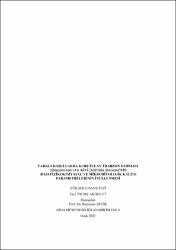| dc.contributor.advisor | Şevik, Ramazan | |
| dc.contributor.author | Yıldız Akbulut, Esra | |
| dc.date.accessioned | 2021-02-22T07:58:06Z | |
| dc.date.available | 2021-02-22T07:58:06Z | |
| dc.date.issued | 2021 | en_US |
| dc.identifier.uri | https://hdl.handle.net/11630/8556 | |
| dc.description.abstract | Kurutma işlemi gıdaların muhafazasında kullanılan en yaygın işlemlerden biridir. Bu çalışmada farklı ortamlarda kurutulan Trabzon hurması ve kivi örneklerinin bazı fizikokimyasal ve mikrobiyolojik kalite parametrelerinin üzerine etkisi araştırılmıştır. Kurutma işlemi fırında, mikrodalgada ve güneşte kurutma olmak üzere 3 farklı ortamda gerçekleştirilmiştir.
Taze ve kurutulan Trabzon hurması ile kivi örneklerinin kuru madde, pH, su aktivitesi, renk (L*,a*,b*) değerleri, tekstür analizi, duyusal analiz, istatistiksel analiz, toplam mezofilik bakteri, maya-küf sayımı, koliform grubu bakteri sayımı ve ozmofil maya değerleri belirlenmiştir.
Trabzon Hurması örneklerinin başlangıç su aktivitesi (a_w) değeri 0,92 iken kurutma işlemi sonrası fırında kurutulmuş hurma 0,72, güneşte kurutulmuş hurma 0,83 ve mikrodalgada kurutulmuş hurma 0,75 olduğu gözlemlenmiştir.
Kivi örneğinin ise başlangıç su aktivitesi (a_w) değeri 0,87 iken kurutma işlemi sonrası fırında kurutulmuş kivi 0,70, güneşte kurutulmuş kivi 0,58 ve mikrodalgada kurutulmuş kivi 0,67 olduğu gözlemlenmiştir.
Renk açısından ise Trabzon hurmasının, L* (parlaklık) değeri, güneşte kurutulmuş hurma ve fırında kurutulmuş hurmanın azaldığı, mikrodalgada kurutulmuş hurmanın ise arttığı gözlemlenmiştir. Kivinin L* (parlaklık) değeri ise güneşte kurutulmuş kivinin azaldığı, fırında kurutulmuş kivi ve mikrodalgada kurutulmuş kivinin arttığı gözlemlenmiştir.
Trabzon hurmasının a* (kırmızılık) ve b* (sarılık) değerleri fırında kurutulmuş hurmada, güneşte kurutulmuş hurmada ve mikrodalgada kurutulmuş hurmada azaldığı gözlemlenmiştir.
Kivinin a* (kırmızılık) ve b* (sarılık) değerleri fırında kurutulmuş kivide, güneşte kurutulmuş kivide ve mikrodalgada kurutulmuş kivide arttığı gözlemlenmiştir.
Duyusal değerlendirmeye göre genel beğeni açısından en çok beğenilen mikrodalgada 100 Watt’ta kurutulan Trabzon hurması, 60°C’de fırında kurutulan kivi ve güneşte kurutulan Trabzon hurması örneği olduğu tespit edilmiştir.
Mikrobiyal yük açısından toplam koliformda üreme olmadığı tespit edilmiştir. Ozmofil mayada ise mikrodalga kivi ve mikrodalga hurmada üreme olmadığı belirlenmiştir. | en_US |
| dc.description.abstract | Drying is one of the most common processes used in food preservation. In this study, the effect of persimmon and kiwi samples dried in different environments on some physicochemical and microbiological quality parameters were investigated. Drying process was carried out in 3 different drying methods; overdrying, microwave drying, sun-drying.
Dry matter, pH, water activity, color (L *, a *, b *) values of fresh and dried persimmon and kiwi samples, texture analysis, sensory analysis, statistical analysis, total mesophilic bacteria, yeast-mold count, coliform group bacteria count and osmofil yeast values were determined.
It was observed that, the initial aw value of the Trabzon persimmon samples was 0,92, when they are dry proccessed in oven the value is 0,72, when they are dried in sunlight the value is 0,83 and when the drying proccess done with microwave the value is 0,75.
Kiwi sample was found to have an initial aw value of 0,87, when dried in oven the value is 0,70, when dried in the sun the value is 0,58 and when the drying proccess done in microwave the value is 0,67.
In terms of color, it was observed that the L * (Brightness) value of Trabzon persimmon is decreased when the drying process are conducted via sunlight of oven but when the process done with microwave the L * value is increased. The L * (Brightness) value of kiwi is decreased when the drying process done in sunlight, but increased when the process is conducted with oven or microwave.
On the subject of Trabzon persimmons a* (redness) and b* (yellowness) values, when the persimmon proccessed via sunlight, oven and microvave these values are observed to be decreased.
On the subject of kiwis a* (redness) and b* (yellowness) values, when the persimmon proccessed via sunlight, oven and microvave these values are observed to be increased.
According to the sendory evaluation, it was determined that the persimmon samples that dried with microwave at 100 W and the kiwi samples that dried at 60 °C in oven and dried via sunlight are the most appericiated in terms of general taste.
It was determined that there was no growth in total coliform in terms of microbial load. It was determined that there was no growth in microwave kiwi and microwave date in osmophilic yeast. | en_US |
| dc.language.iso | tur | en_US |
| dc.rights | info:eu-repo/semantics/openAccess | en_US |
| dc.subject | Kurutma | en_US |
| dc.subject | Trabzon Hurması | en_US |
| dc.subject | Kivi | en_US |
| dc.subject | Fizikokimyasal | en_US |
| dc.subject | Mikrobiyolojik | en_US |
| dc.title | Farklı koşullarda kurutulan Trabzon hurması (diospyros kaki) ve kivi (actinidia deliciosa)’nin bazı fizikokimyasal ve mikrobiyolojik kalite parametrelerinin incelenmesi | en_US |
| dc.title.alternative | Investigation of some physicochemical and microbiological quality parameters of persimmon (diospyros kaki) and kiwi (actinidia deliciosa) dried in different conditions | en_US |
| dc.type | masterThesis | en_US |
| dc.department | Mühendislik Fakültesi | en_US |
| dc.identifier.startpage | 1 | en_US |
| dc.identifier.endpage | 52 | en_US |
| dc.relation.publicationcategory | Tez | en_US |
| dc.contributor.institutionauthor | Yıldız Akbulut, Esra | |



















